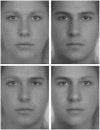Modifications of Visual Field Asymmetries for Face Categorization in Early Deaf Adults: A Study With Chimeric Faces
- PMID: 28163692
- PMCID: PMC5247456
- DOI: 10.3389/fpsyg.2017.00030
Modifications of Visual Field Asymmetries for Face Categorization in Early Deaf Adults: A Study With Chimeric Faces
Abstract
Right hemisphere lateralization for face processing is well documented in typical populations. At the behavioral level, this right hemisphere bias is often related to a left visual field (LVF) bias. A conventional mean to study this phenomenon consists of using chimeric faces that are composed of the left and right parts of two faces. In this paradigm, participants generally use the left part of the chimeric face, mostly processed through the right optic tract, to determine its identity, gender or age. To assess the impact of early auditory deprivation on face processing abilities, we tested the LVF bias in a group of early deaf participants and hearing controls. In two experiments, deaf and hearing participants performed a gender categorization task with chimeric and normal average faces. Over the two experiments the results confirmed the presence of a LVF bias in participants, which was less frequent in deaf participants. This result suggested modifications of hemispheric lateralization for face processing in deaf participants. In Experiment 2 we also recorded eye movements to examine whether the LVF bias could be related to face scanning behavior. In this second study, participants performed a similar task while we recorded eye movements using an eye tracking system. Using areas of interest analysis we observed that the proportion of fixations on the mouth relatively to the other areas was increased in deaf participants in comparison with the hearing group. This was associated with a decrease of the proportion of fixations on the eyes. In addition these measures were correlated to the LVF bias suggesting a relationship between the LVF bias and the patterns of facial exploration. Taken together, these results suggest that early auditory deprivation results in plasticity phenomenon affecting the perception of static faces through modifications of hemispheric lateralization and of gaze behavior.
Keywords: categorization task; chimeric face; early deafness; eye movements; gender; hemispheric laterality.
Figures




Similar articles
-
Visual field bias in hearing and deaf adults during judgments of facial expression and identity.Front Psychol. 2013 Jun 6;4:319. doi: 10.3389/fpsyg.2013.00319. eCollection 2013. Front Psychol. 2013. PMID: 23761774 Free PMC article.
-
Does face-selective cortex show a left visual field bias for centrally-viewed faces?Neuropsychologia. 2021 Aug 20;159:107956. doi: 10.1016/j.neuropsychologia.2021.107956. Epub 2021 Jul 13. Neuropsychologia. 2021. PMID: 34265343 Free PMC article.
-
Face gender categorization and hemispheric asymmetries: Contrasting evidence from connected and disconnected brains.Neuroscience. 2016 Dec 17;339:210-218. doi: 10.1016/j.neuroscience.2016.10.021. Epub 2016 Oct 13. Neuroscience. 2016. PMID: 27746345
-
Left visual field bias during face perception aligns with individual differences in reading skills and is absent in dyslexia.Br J Educ Psychol. 2025 Jun;95(2):270-279. doi: 10.1111/bjep.12559. Epub 2022 Oct 31. Br J Educ Psychol. 2025. PMID: 36317253 Free PMC article.
-
Natural, but not artificial, facial movements elicit the left visual field bias in infant face scanning.Neuropsychologia. 2014 Sep;62:175-83. doi: 10.1016/j.neuropsychologia.2014.07.017. Epub 2014 Jul 24. Neuropsychologia. 2014. PMID: 25064049 Free PMC article.
Cited by
-
Electrophysiological Dynamics of Visual Speech Processing and the Role of Orofacial Effectors for Cross-Modal Predictions.Front Hum Neurosci. 2020 Oct 27;14:538619. doi: 10.3389/fnhum.2020.538619. eCollection 2020. Front Hum Neurosci. 2020. PMID: 33192386 Free PMC article.
-
Social perception in deaf individuals: A meta-analysis of neuroimaging studies.Hum Brain Mapp. 2023 Nov;44(16):5402-5415. doi: 10.1002/hbm.26444. Epub 2023 Aug 23. Hum Brain Mapp. 2023. PMID: 37609693 Free PMC article.
References
LinkOut - more resources
Full Text Sources
Other Literature Sources

